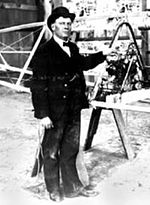Thomas Scott Baldwin
| Thomas Scott Baldwin | |
|---|---|
 |
|
| Born |
June 30, 1854 Marion County, Missouri |
| Died | May 17, 1923 (aged 68) |
| Occupation | Balloonist |
| Spouse(s) | Cary Poole |
| Parent(s) | Samuel Yates Baldwin |
Thomas Scott Baldwin (June 30, 1854 – May 17, 1923) was a pioneer balloonist and U.S. Army major during World War I. He was the first American to descend from a balloon by parachute.
He was born on June 30, 1854 to Jane and Samuel Yates Baldwin. He worked as a brakeman on the Illinois railroad, then joined a circus working as an acrobat. In 1875 he started an act combining trapeze and a hot air balloon.
On January 30, 1885 he made one of the earliest recorded parachute jumps from a balloon. Baldwin repeated the feat on multiple occasions as a paid entertainer, netting $1500 from one dangerous jump over the water from 600 feet at Rockaway Beach in August 1887 marred by parachute difficulties.
In 1900, Baldwin created a small pedal-motorized powered airship. It never served as anything more than a curiosity. In 1902-1903 he supervised the construction of the California Eagle based on the ideas of August Greth and financed by the American Aerial Navigation Company of San Francisco. It incorporated a French DeDion Bouton automotive engine and paddle propeller based on marine technology so prevalent in airship design in the period. After collaborating with Greth and John J. Montgomery in 1903-1904, Baldwin acquired sufficient knowledge to begin his own independent airship project.
In June and July, 1904 Baldwin built an aerodynamic cigar-shaped, hydrogen gas filled, balloon. He created the dirigible "California Arrow", which incorporated a 7-HP Hercules motorcycle engine manufactured by Glenn H. Curtiss of Hammondsport, NY. With Lincoln Beachey as his pilot, the Arrow underwent the first controlled circular flight in America on August 3, 1904 at Idora Park in Oakland, California. Later in October and November, 1904, the aircraft was piloted by Roy Knabenshue at the 1904 Louisiana Purchase Expositionin St. Louis.
In August 1908, after several test flights at Fort Myer, Virginia, the Army Signal Corps paid him $10,000 for a dirigible that could be used for sustained and controlled navigation. Baldwin created a dirigible that was 95 feet (29 m) long and powered by a new, more powerful Curtiss engine. The Army bought it and designated its first dirigible "SC-I" (Signal Corps Dirigible Number 1). Baldwin picked up the sobriquet: "Father of the American Dirigible." He received the Aero Club of America's first balloon pilot certificate.
...
Wikipedia
